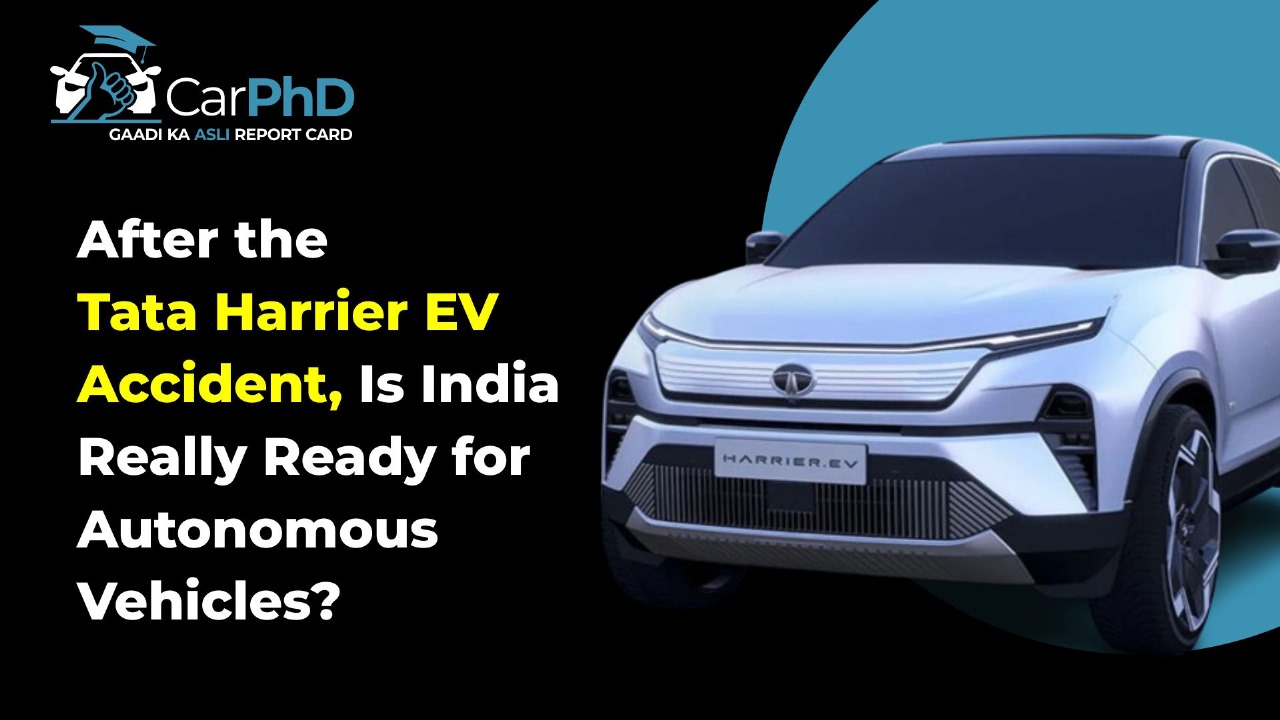
Car

Car

On August 14, 2025 (per CCTV timestamp), a Tata Harrier.ev allegedly moved in “Summon” mode outside a shop in Avinashi, Tamil Nadu, fatally injuring a man. Video of the incident went viral, prompting statements from Tata Motors and a national debate on whether India is prepared for autonomous features—even limited ones like remote maneuvering.
ADAS vs. Autonomy: Don’t Confuse the Twop
Anuj Guglani, CEO, Car PhD commented, ’Most vehicles sold in India today—including the Harrier.ev—offer ADAS (Level 1–2) such as AEB, lane assist, and parking/summon-like functions. These are driver-assist aids, not self-driving. India has no AV-specific law authorizing driverless operation on public roads; the Motor Vehicles Act and 2017 Driving Regulations still presume an attentive human driver is responsible.
Where Policy Stands Today
India has moved on adjacent safety rails—e.g., AIS-189 on vehicle cybersecurity—yet a comprehensive AV framework (testing permits, remote operation rules, data logging, liability) is still nascent. Multiple analyses this year note the absence of an India-wide AV statute and the need to adapt legacy laws for autonomy.
What the Harrier.ev Incident Exposed
• Human factors & HMI: Features like Summon demand crystal-clear UX, fail-safes (e.g., door/seat/phone proximity interlocks), and conservative default behaviors on slopes or tight spaces. The Avinashi crash suggests gaps across user understanding, environment, and safeguards.
• Dealer delivery & training: Advanced functions require standardized handovers, checklists, and user certification—not just a brief demo. (Industry commentary after the incident has emphasized this.)
• Event data & accountability: India lacks mandated “black box” standards for ADAS/AV events to reconstruct cause quickly and assign responsibility. Comparative policy trackers highlight how many countries now legislate this; India should follow.
India’s Readiness: A Frank Scorecard
Technology: OEMs can ship robust Level-2 ADAS; however, India’s heterogeneous traffic, signage variability, lane discipline, and unstructured road behavior make higher autonomy far tougher without HD maps and V2X density. Not ready for driverless; cautiously ready for tightly limited assists. (Five-star crash ratings on some models are good for occupant safety but orthogonal to autonomy readiness.)
Infrastructure: Patchy lane markings, inconsistent signage, and limited digital twins/HD maps mean wide-area autonomy will struggle beyond geofenced pilots. (Global policy reviews show countries enabling AVs start with restricted zones and detailed mapping.)
Regulation & Liability: No national AV testing law, ambiguous liability apportionment between driver, OEM, and software vendor, and no uniform data-recorder mandate. Under-prepared.
Enforcement & Public Trust: After a high-profile fatality tied to an advanced feature, transparent investigations and recalls/OTA audits are essential to maintain confidence. Media reports indicate Tata Motors has responded, but India needs systemic processes, not case-by-case reactions.
A 10-Point Roadmap (Pragmatic, Near-Term)
1. Define levels & labels: Mandate plain-English labels for features (e.g., “Driver-Assist Only—Hands On”) and on-screen disclaimers in major Indian languages.
2. Permit scheme for autonomy: Create a national AV Testing Code with permits, safety drivers, remote-operation rules, incident reporting, and public dashboards.
3. Event Data Recorders (EDR): Standardize ADAS/AV logs (sensor, commands, OTA version) and retention to enable fair investigations and insurance adjudication.
4. Human-factors safeguards: For summon/remote maneuvers, require door/seat occupancy checks, phone proximity, slope detection, obstacle-first logic, and “dead-man” style continuous input.
5. Dealer & user certification: Mandatory delivery training with a short assessment before enabling advanced features; periodic digital refreshers.
6. OTA governance: Notify regulators of safety-relevant firmware; require post-update validation and owner acknowledgement before re-enabling features.
7. Geofenced pilots: Start with low-complexity corridors/campuses where HD maps, V2X, and enforcement are in place; publish safety metrics quarterly.
8. Cybersecure by design: Enforce AIS-189 across connected features; periodic penetration tests and public CVE disclosures for critical issues.
9. Insurance & liability matrix: Define when liability shifts (driver ↔ OEM ↔ software provider) and require AV feature logs in claims.
10. Public communication: Rapid, transparent incident briefings and independent technical probes to prevent rumor cycles after crashes.
Bottom Line
India is not yet ready for driverless autonomy on public roads, and the Harrier.ev tragedy underscores why. But India is ready to scale well-governed Level-2 driver-assist—provided we pair tech with rigorous human-factors design, training, event-data standards, and a clear regulatory backbone. The fastest path forward: geofenced pilots + national rules, before anything resembling hands-off driving becomes commonplace.
Note: This article reflects reports published on August 22–23, 2025 (IST) and the CCTV timestamp of August 14, 2025, regarding the Avinashi, Tamil Nadu incident.